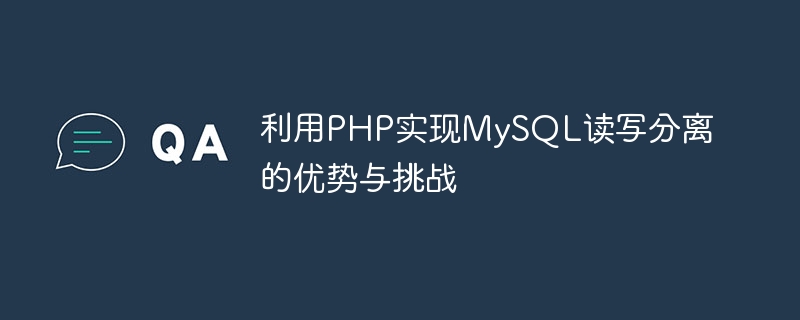

Advantages and challenges of using PHP to implement MySQL read-write separation
As the scale of web applications continues to expand and the number of visits increases, Database read and write performance has become a key challenge faced by developers. In order to solve this problem, many developers began to use MySQL read-write separation technology to improve database processing capabilities. This article will explore how to use PHP to achieve MySQL read and write separation, while analyzing its advantages and challenges.
There are usually two ways to implement MySQL read-write separation in PHP: one is manual control, and the other is to use a third party Library.
In PHP, you can connect to the MySQL database through extensions such as mysqli or PDO, and manually control the separation of reading and writing in the code. The following is a simple example:
// 主数据库写操作
$mysqli = new mysqli("主数据库地址", "用户名", "密码", "数据库名");
$mysqli->query("INSERT INTO table_name (column1, column2) VALUES ('value1', 'value2')");
// 从服务器读操作
$mysqli_read = new mysqli("从服务器地址", "用户名", "密码", "数据库名");
$result = $mysqli_read->query("SELECT * FROM table_name");In order to more conveniently implement MySQL read and write separation, you can use some third-party libraries, such as Medoo, RedBeanPHP, etc. These class libraries provide more advanced database operation methods and simplify the implementation of read-write separation.
// 使用Medoo库连接数据库
require 'Medoo.php';
$database = new Medoo([
'database_type' => 'mysql',
'database_name' => 'database_name',
'server' => '从服务器地址',
'username' => '用户名',
'password' => '密码',
'charset' => 'utf8'
]);
// 读取数据
$data = $database->select("table_name", "*");MySQL read-write separation is an important technical means to improve database processing capabilities. Implementing read-write separation in PHP can effectively improve the performance and availability of the system. Developers need to fully understand its advantages and challenges, and rationally design and implement read-write separation solutions to meet the needs of different application scenarios.
Through the above introduction, I believe readers have a deeper understanding of the advantages and challenges of using PHP to achieve MySQL read-write separation. I hope it can help developers better apply this technology to optimize their own Web application.
The above is the detailed content of Advantages and Challenges of Using PHP to Separate MySQL Read and Write. For more information, please follow other related articles on the PHP Chinese website!